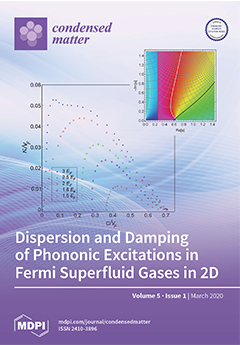This article provides a focused review of recent findings which demonstrate, in some cases quite counter-intuitively, the existence of bound states with a singularity of the density pattern at the center; the states are physically meaningful because their total norm converges. One model
[...] Read more.
This article provides a focused review of recent findings which demonstrate, in some cases quite counter-intuitively, the existence of bound states with a singularity of the density pattern at the center; the states are physically meaningful because their total norm converges. One model of this type is based on the 2D Gross–Pitaevskii equation (GPE), which combines the attractive potential
and the quartic self-repulsive nonlinearity, induced by the Lee–Huang–Yang effect (quantum fluctuations around the mean-field state). The GPE demonstrates suppression of the 2D quantum collapse, driven by the attractive potential, and emergence of a stable ground state (GS), whose density features an integrable singularity
at
. Modes with embedded angular momentum exist too, but they are unstable. A counter-intuitive peculiarity of the model is that the GS exists even if the sign of the potential is reversed from attraction to repulsion, provided that its strength is small enough. This peculiarity finds a relevant explanation. The other model outlined in the review includes 1D, 2D, and 3D GPEs, with the septimal (seventh-order), quintic, and cubic self-repulsive terms, respectively. These equations give rise to stable singular solitons, which represent the GS for each dimension
D, with the density singularity
. Such states may be considered the results of screening a “bare” delta-functional attractive potential by the respective nonlinearities.
Full article





